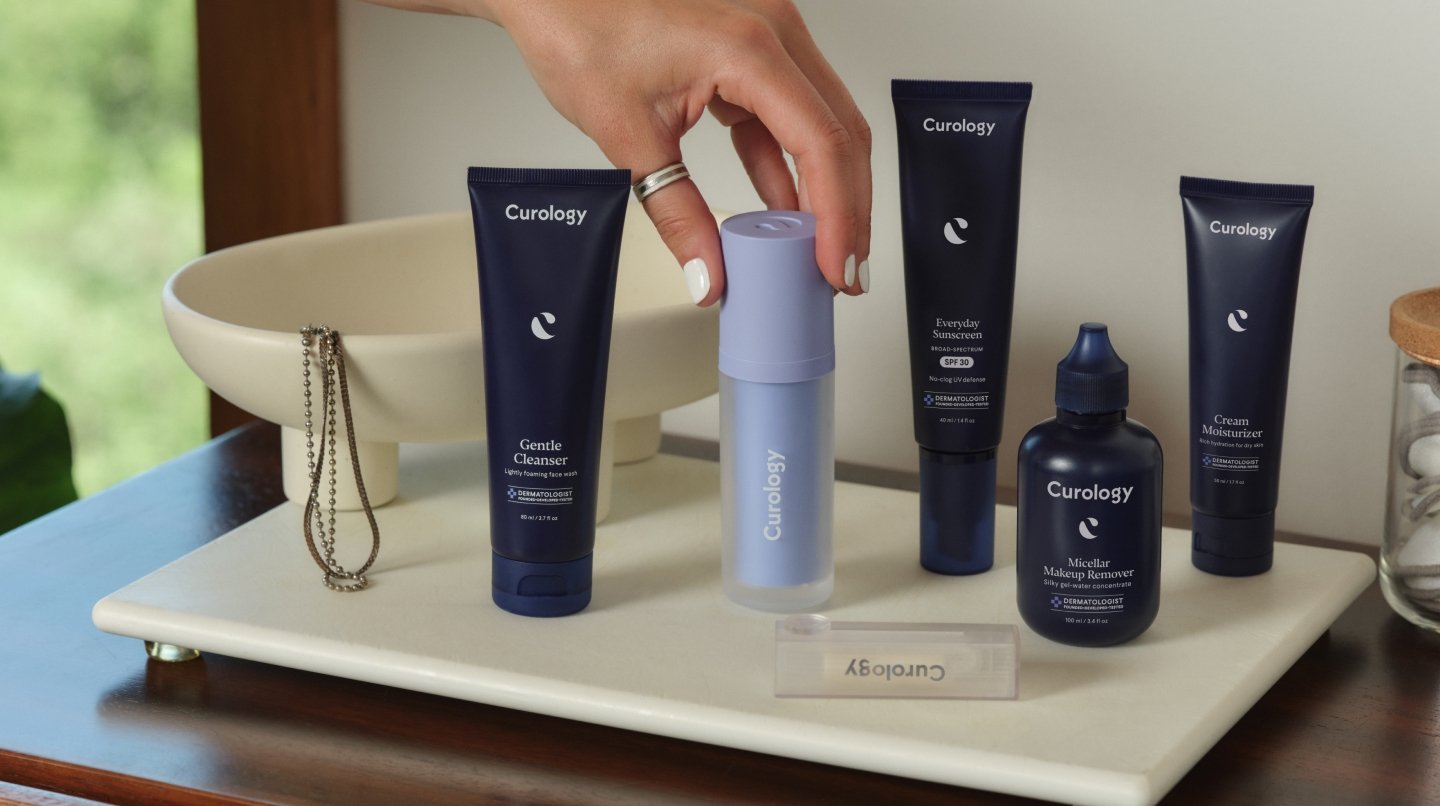How it works:
Share your skin goals and snap selfies
Your dermatology provider prescribes your formula
Apply nightly for happy, healthy skin
How it works:
How it works:
Share your skin goals and snap selfies
Your dermatology provider prescribes your formula
Apply nightly for happy, healthy skin
How it works:
Face mites: What are they and how do you get rid of them?
Believe it or not, they’re pretty common—and keeping them away is easier than you might think.



Did you know that microscopic mites can live on human skin? That might sound gross or scary, but they can be common, similar to normal bacteria that lives on and inside our bodies. Also known as Demodex, they are tiny parasites that reside near the hair follicles (most commonly on the face). Most people are completely unaware that they exist, as most have no symptoms.
However, they may contribute to skin conditions in some people. There is increasing evidence suggesting that the Demodex mite plays a role in the inflammation seen in rosacea.¹ The cause of rosacea is still unknown, and the role the Demodex mite plays in the development of rosacea is still uncertain,² but symptoms are considered to be similar (if there are symptoms at all). Treatment can also overlap in some cases. If you’re concerned about rosacea or Demodex mites, be sure to schedule a consultation with a licensed dermatology provider.
What are face mites?
There are about 65 types of Demodex mites, of which two types are commonly found on human skin. One of these is known to live on or around hair follicles and eyelashes and consume dead skin cells; these are the Demodex folliculorum. The other type, Demodex brevis, consumes excess sebum and hangs out near the oil glands.³ It may seem weird that humans can have microscopic mites and not even know it—but don’t stress, they are fairly common!
How common are face mites?
Luckily, most people are completely unaware that Demodex mites exist and are completely asymptomatic, despite being carriers. They are most commonly found living in or around the ear canals, forehead, nose, and nipples.⁴
How are face mites detected?
You won’t be able to find these mites by looking in the mirror, but Demodex mites can be detected using skin biopsies and other sampling methods such as skin scrapings and comedone extractions.⁵ Infestation of these mites are more easily detected the older you are, however, the number of mites in humans often peaks in those who are between 20 and 30 years old. This is because individuals in their 20s and 30s commonly produce sebum at a higher rate.⁶ If you’re concerned about Demodex, consult with your licensed dermatology provider, who will be able to determine if a test is required.
What are the symptoms?
Despite many people being carriers, the majority never show symptoms. There are some populations, however, who are more likey to develop symptoms.
At-risk populations
There is research that connects Demodex infestations with rosacea, seborrheic dermatitis, and acne vulgaris.⁷ Experts believe that Demodex may have a direct role in rosacea or present in a way that is similar to rosacea.⁸
Studies also show that, as with many conditions, people who are immunocompromised may be more at risk for developing a skin disorder involving face mites. The most common conditions suppressing someone's immune system include cancer, autoimmune disorders, human immunodeficiency virus (HIV), and those have received corticosteroid or immunotherapy drugs.⁹
Human demodicosis
Human demodicosis is a general term used to describe all skin conditions caused by the Demodex mite. These conditions can present as general skin irritation but can also include dryness, scaling, pustules, and vesicles. Those who have a large number of mites on their skin may present with a variety of symptoms, which may include:¹⁰
Erythema (redness)
Pruritus (itchy skin)
Acneiform lesions
Seborrheic dermatitis (severe type of dandruff)
Skin flushing
Comedones (white heads)
Telangiectasia (abnormal blood vessels)
Alopecia
Research on the role Demodex mites may play in androgenetic alopecia (hair loss) is conflicted. Between inflammatory properties within the body, genetic factors, and sebaceous glands, it is difficult to determine if the alopecia is caused by mite infestation or if the infestation is secondary to the alopecia.¹¹
Blepharitis
Demodex mites may also play a role in the common eye condition, blepharitis. Blepharitis is described as an inflammatory eye condition affecting the sebaceous glands, skin, eyelashes, and lash follicles. Some studies have shown that Demodex is involved in 30-90% of blepharitis cases.¹²
Blepharitis can be broken down into two types: anterior and posterior and Demodex may be involved in the development of both. The D. folliculorum species may find a home near the lash follicle and therefore may have an involvement in anterior blepharitis. The D. brevis species may burrow deeper into the sebaceous glands and may be associated with posterior blepharitis.¹³
There are no specific symptoms that signal if Demodex is involved, but the most common symptoms of blepharitis may include:¹⁴
Loss of eyelashes
Swollen and irritated eyelids
Burning
Itching
Crusting/matting
The sensation that something is stuck in your eye
The diagnosis of Demodex blepharitis is commonly done by putting eyelashes under a microscope. There are no FDA-approved treatments for Demodex blepharitis, but some recommended treatments may include tea tree oil and eyelid cleansers.¹⁵
Treatment options
When indicated, topical application of the antiparasitic medication, ivermectin (which can be prescribed at Curology), has been shown to have a positive effect on the treatment of Demodex mite infestations.¹⁶ Other treatment options that may be used to treat Demodex mites include the topical medication permethrin cream, as well as topical and oral metronidazole.¹⁷ Some research also supports using tea tree oil to aid in treatment methods, specifically for Demodex blepharitis.¹⁸
How to prevent face mites
Face mites might be common—but you might be wondering, are there any ways you can prevent them from living on your skin? The answer is simple: Find a skincare routine that works for you and stick to it. Here are a few key pointers that may help keep mites from multiplying:¹⁹
Wash your face twice daily and don’t forget the eyelids! Avoid greasy makeup. If you wear it, be sure to wash it all off before bed.
Wash your pillowcase often. Since we all sleep on our pillows, our pillowcases tend to collect dead skin cells and bacteria. If these aren’t washed often, it could allow bacteria and mites to transfer back onto the skin.
Exfoliate! Whether this is a chemical exfoliator or you see an aesthetician regularly for an exfoliating facial, find what works for you.
Taking care of your skin
It is essential to remember that not all microbes are necessarily harmful; they may serve a purpose. Just like our gut contains “good bacteria,” some feel that face mites may contribute to getting rid of dead skin cells and oil on your skin.
Either way, the fact that face mites are considered normal should put your mind at ease. It's always a good idea to reach out to your dermatologist if there are any skin conditions or symptoms that feel abnormal—and it’s a great idea to follow a skincare routine that puts the health of your complexion first.
Get your personalized skincare routine with Curology
Get your personalized skincare routine with Curology


Curology offers consultations with licensed dermatology providers who can help develop a skincare routine tailored to you. Sign up for a 30-day trial* to embark on your journey to personalized skincare today!
FAQs
The key is to make sure that you establish a strong skincare routine. Experts recommend washing your face twice a day, exfoliating regularly, washing your pillowcase often, and toning down the use of any greasy or oil-based products.
Evidence has shown that the antiparasitic medication, Ivermectin, is therapeutic in the treatment of Demodex mites. Other treatment options include metronidazole, an antibiotic that may also be effective at helping rid face mites. Permethrin, a topical medication often used as treatment for lice and scabies, is another option. Regardless of treatment, be sure to follow the guidance of your medical provider when treating Demodex mites.
The exact cause is unknown, but according to experts, many people can have them and never know it. There have been some studies that believe there could be a correlation between rosacea and Demodex mites.
No, Demodex are usually not harmful. In fact, most people have no idea they have them as most have no symptoms. In some situations, skin irritation or human demodicosis may occur, which may require treatment. Some individuals may also experience symptoms similar to rosacea.
P.S. We did the homework, so you don’t have to:
Forton, F.M.N. The Pathogenic Role of Demodex Mites in Rosacea: A Potential Therapeutic Target Already in Erythematotelangiectatic Rosacea?. Dermatology and Therapy. (2020, October 23).
Forton, F.M.N. The Pathogenic Role of Demodex Mites in Rosacea: A Potential Therapeutic Target Already in Erythematotelangiectatic Rosacea?. Dermatology and Therapy. Ibid.
Rather, P.A. and Hassan, I. Human Demodex Mite: The Versatile Mite of Dermatological Importance. Indian Journal of Dermatology. (January-February 2014).
Smith, G., et al. Human Follicular Mites: Ectoparasites Becoming Symbionts. Molecular Biology and Evolution. (2022, June 21).
Rather, P.A. and Hassan, I. Human Demodex Mite: The Versatile Mite of Dermatological Importance. Indian Journal of Dermatology. Ibid.
Smith, G., et al. Human Follicular Mites: Ectoparasites Becoming Symbionts. Molecular Biology and Evolution. Ibid.
Karabay, E.A. and Cerman, A.A. Demodex folliculorum infestations in common facial dermatoses: acne vulgaris, rosacea, seborrheic dermatitis. An Bras Dermatol. (2020, February 12).
Rather, P.A. and Hassan, I. Human Demodex Mite: The Versatile Mite of Dermatological Importance. Indian Journal of Dermatology. Ibid.
Rather, P.A. and Hassan, I. Human Demodex Mite: The Versatile Mite of Dermatological Importance. Indian Journal of Dermatology. Ibid.
Rather, P.A. and Hassan, I. Human Demodex Mite: The Versatile Mite of Dermatological Importance. Indian Journal of Dermatology. Ibid.
Rather, P.A. and Hassan, I. Human Demodex Mite: The Versatile Mite of Dermatological Importance. Indian Journal of Dermatology. Ibid.
AJMC Perspectives. Unmet Needs in the Management of Demodex Blepharitis. American Journal of Managed Care. (2022, September 20).
AJMC Perspectives. Unmet Needs in the Management of Demodex Blepharitis. American Journal of Managed Care. Ibid.
AJMC Perspectives. Unmet Needs in the Management of Demodex Blepharitis. American Journal of Managed Care. Ibid.
AJMC Perspectives. Unmet Needs in the Management of Demodex Blepharitis. American Journal of Managed Care. Ibid.
Kubanov, A., et al. Clinical picture, diagnosis and treatment of rosacea, complicated by Demodex mites. Dermatology Reports. (2019, n.d.).
Rather, P.A. and Hassan, I. Human Demodex Mite: The Versatile Mite of Dermatological Importance. Indian Journal of Dermatology. Ibid.
Savla, K., et al. Tea tree oil for Demodex blepharitis. Cochrane Database Syst Rev. (2019, June 9).
Rather, P.A. and Hassan, I. Human Demodex Mite: The Versatile Mite of Dermatological Importance. Indian Journal of Dermatology. Ibid.
Melissa Hunter is a board certified family nurse practitioner at Curology. She received her MSN from George Washington University in Washington, DC.
*Cancel anytime. Subject to consultation. Results may vary.
We’re here to tell you what we know. That’s why our information is evidence-based and fact-checked by medical experts. Still, everyone’s skin is unique—the best way to get advice is to talk to your healthcare provider.
Empowering you with knowledge is our top priority. Our reviews of other brands’ products in this post are not paid endorsements—but they do meet our medically fact-checked standards for ingredients (at the time of publication).

Curology Team

Melissa Hunter, NP-C
Related Articles
Sunscreen for eyes: How to protect your delicate skin from UV raysYour first weeks on CurologyWrinkles and other signs you’re doing it rightWhy Curology is cruelty-free and vegan-friendlyThe science behind our skincare quiz: why it worksPopular Articles
Ask Curology: Is my cold breaking me out?Slugging: The dermatologist-approved skincare hack going viral on TikTokTretinoin vs retinol: What’s the difference?How to create a self-care routine that actually sticksYour 2023 skincare horoscopeTry prescription skincare
Get routine essentials

Good skin days ahead
- Breakouts
- Redness
- Fine lines
- Dark spots
- Hair thinning